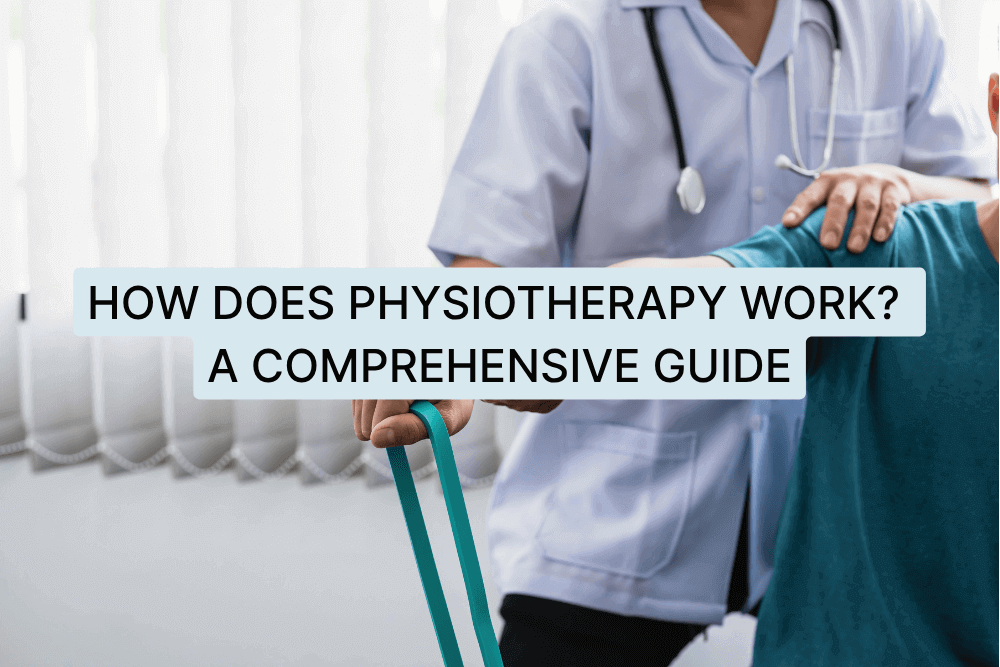If you’re dealing with pain, stiffness, or limited movement, physiotherapy could be the key to feeling better. But how does it actually work? In this blog, we’ll break down what physiotherapy is, how it helps your body heal, and what to expect during treatment.
By the end of this article, you’ll understand:
- What physiotherapy really is and how it works
- What conditions it can help treat
- How long therapy usually takes to show results
- What a typical session looks like
- Why physiotherapy is safe and worth trying
Let’s explore how physiotherapy works and what it can do to support your recovery and long-term health.
What Is Physiotherapy?
Physiotherapy (also called physical therapy) is a way to help people move better and feel less pain. It’s a type of healthcare that focuses on your muscles, joints, bones, and nerves.
Physiotherapists are trained professionals who use movement, hands-on care, and exercises to help people:
- Recover from injuries
- Get stronger after surgery
- Manage long-term conditions like arthritis
- Improve balance and posture
- Reduce pain and stiffness
Think of a physiotherapist as a movement expert. Whether you have a sports injury, a bad back, or recovering after a stroke, they can create a plan that fits your body’s needs.
How Does Physiotherapy Work?
Physiotherapy works by helping your body heal naturally. Here’s how:
1. Assessment and Diagnosis
First, your physiotherapist will talk to you about your symptoms, medical history, and lifestyle. Then, they’ll check your movement, strength, flexibility, and posture.
This helps them identify the root cause of your issue and design the most effective treatment.
2. Personalized Treatment Plan
No two people are the same. Your physiotherapist will make a treatment plan just for you. It may include:
- Exercise therapy: Gentle movements to build strength and stretch tight muscles.
- Manual therapy: Hands-on techniques like massage, joint mobilization, or soft tissue release.
- Electrotherapy: Devices like ultrasound or TENS machines that reduce pain and inflammation.
- Posture and movement training: Correcting your movement patterns to prevent future injuries.
- Education: Teaching you how to care for your body at home.
According to a study published in the National Library of Medicine, early physiotherapy can significantly improve recovery outcomes. In fact, patients who begin therapy within weeks of an injury are twice as likely to experience greater improvements in pain and disability than those who wait to start treatment. This highlights the importance of starting physiotherapy early to get the best results for conditions like back pain and neck injuries.
What Conditions Can Physiotherapy Treat?
Physiotherapy can help with many issues, including:
- Neck and back pain
- Sports injuries (like sprains, strains, tennis elbow)
- Frozen shoulder
- Joint pain (knee, hip, shoulder)
- Post-surgery recovery
- Stroke or neurological rehab
- Arthritis
- Sciatica
- Muscle weakness or imbalance
Whether it’s a recent injury or a long-standing condition, physiotherapy can make a meaningful difference.
How Long Does Physiotherapy Take?
This is one of the most common questions—and the answer is: it depends.
Here are some general timelines:
- Mild injuries (like a sprain or strain): 2 to 4 weeks
- Moderate conditions (like frozen shoulder or sciatica): 4 to 8 weeks
- Chronic conditions (like arthritis or stroke rehab): Several months, with regular sessions
Keep in mind, your recovery also depends on how consistent you are with your exercises and lifestyle changes. Your physiotherapist will track your progress and adjust the plan as needed.
How Long Is a Physical Therapy Session?
Most physiotherapy sessions last between 30 to 60 minutes. Here’s what usually happens during a session:
- A quick check-in to see how you’re feeling
- Hands-on treatment or guided exercises
- Advice on home exercises
- Tips to prevent the problem from coming back
If you’re starting therapy for the first time, the first session might take a little longer for a full assessment.
Is Physiotherapy Safe?
Yes, physiotherapy is very safe when done by a licensed professional. It’s a natural, drug-free way to recover. You may feel some soreness after exercises just like after a workout but it usually goes away quickly.
Final Thoughts
Physiotherapy is a powerful tool to help your body heal, move better, and feel stronger. Whether you’re recovering from pain or simply want to move better, a physiotherapist can guide you step by step.
If you’re thinking about trying physiotherapy, talk to a qualified professional. The earlier you start, the faster you can get back to doing the things you love without pain holding you back.
Need help finding the right treatment in Dubai?
At Physioveda Medical Center, we offer expert physiotherapy services tailored to your needs. Book your assessment today and start your journey toward pain relief and better movement.

Amit Saraswat is a dedicated physiotherapist who has redefined traditional physiotherapy in India and around the world by introducing a holistic approach to body health and wellness. Through his visionary work, he has set numerous benchmarks in the field and is credited with several pioneering physiotherapy initiatives.

